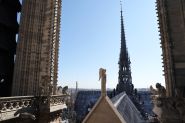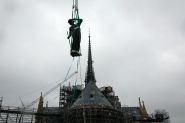
Jean-Charles de Castelbajac unveils modern and minimalist liturgical vestments for Notre-Dame’s reopening, blending humility and vibrant colors in a powerful homage to history and hope through the symbolism of the cross.
Bursts of red, blue, green, and yellow velvet radiate from a large golden cross affixed to a humble ecru wool gabardine: on Friday, Jean-Charles de Castelbajac revealed to AFP the new liturgical vestments for Notre-Dame de Paris.
Light reflects off a door resembling a stained-glass window in a Paris apartment in the 17th arrondissement, cluttered with eclectic objects. It is here that "JCC," 74, designed the paraments (liturgical garments and ornaments) that will accompany the cathedral’s reopening celebrations on December 7 and 8, five years after the devastating fire.
“This wasn’t about creating luxury clothing but about speaking of lux (light, in Latin),” explains the designer, describing a minimalist approach, far from the ornate, richly embroidered garments traditionally associated with Catholic worship.
A versatile artist and practicing Christian known for his angels with gentle faces, Castelbajac admits that his style had become “too pretty, too ornamental.”
“We decided, with the diocese, that there would be no drawings and that I would create a simplified design,” using ornaments “that foster a sense of closeness,” speaking to children, believers, and atheists alike, he summarizes.
A vivid memory from his youth deeply influenced the project: the sight of a robe from Notre-Dame’s treasury that belonged to Saint Louis. “It was a cruciform object, extremely simple,” he recalls with emotion, “and it inspired my entire career as a designer.”
He describes this project as “the culmination” of his work, humbly placing himself within the cathedral’s long history, “like a companion.”
"A Palette of the People"
Meticulously, JCC unfolds the drapery of the chasubles, which he describes as “knightly.” They are adorned like sweatshirts to infuse a modern touch. Over a year and a half, he collaborated with exceptional French craft houses (Lesage, Goossens, Paloma, Montex, Maison Michel...), grouped within the 19M ateliers in Paris, to create a simple yet powerful symbolism.
Seated at his table, Jean-Charles cuts sheets of red, green, blue, and yellow paper—his signature colors, which he calls “universal,” a “palette of the people.” He arranges the pieces around a cross, explaining his sketches: deacons’ vestments with gold, red, and blue grid patterns evoking a “medieval Mondrian,” banners, bishops’ chasubles, and miters adorned with a large golden cross.
“I built these liturgical garments around a radiant cross, which conveys joy, hope, and unity through the multiplicity of colors,” he passionately shares.
“From the very start of my career, I kidnapped the rainbow,” he jokes. “Each morning in school, I found comfort in the colors reflected in the stained glass.” This rainbow vision forms an intimate connection with the Church, with which he has collaborated before, notably dressing Pope John Paul II for World Youth Day in 1997.
In his designs, red symbolizes the blood of Christ, blue represents Mary, green stands for hope, and yellow signifies gold, “a synthesis of everything.”
Faith and Hope in a "Dystopian Era"
For JCC, the arrangement of colors must inspire hope and strength. This epic dimension aims to motivate younger generations in what he describes as a dystopian era. The Notre-Dame fire in April 2019 appeared to him as a “signal” of a world in distress. Yet, as an “indefatigable optimist,” he also saw it as “the fire of hope.” Upon returning home, he sketched rainbows and angels.
“The battle is within each of us,” he concludes, defending his “compassionate art,” which he describes as “kind” and “not trendy.” With a mischievous grin, he adds, “Today, working for the Church is almost more rock ’n’ roll than being with the Sex Pistols on the Thames in 1977.”
With AFP




Comments